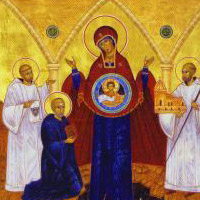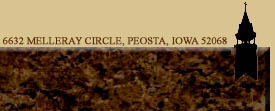 The holy abbots Robert of Molesme, Alberic and Stephen Harding gave the Benedictine tradition a particular form when in 1098 they built the New Monastery of Citeaux and founded the Cistercian Order. About 1125, Saint Stephen established the nuns' monastery of "Tart" as Citeaux's own daughter-house, and entrusted it to the pastoral care of the abbot of this monastery. Under the influence of Saint Bernard of Clairvaux and others the ideal of their reform spread and monasteries of monks and nuns following the Cistercian way of life multiplied even beyond western Europe. From the very beginning, the Order received lay brothers and lay sisters. A substantial spiritual heritage was engendered through the lives and labors of innumerable brothers and sisters that found expression in writing, chant, architecture and crafts, and in the skillful management of their lands.
The holy abbots Robert of Molesme, Alberic and Stephen Harding gave the Benedictine tradition a particular form when in 1098 they built the New Monastery of Citeaux and founded the Cistercian Order. About 1125, Saint Stephen established the nuns' monastery of "Tart" as Citeaux's own daughter-house, and entrusted it to the pastoral care of the abbot of this monastery. Under the influence of Saint Bernard of Clairvaux and others the ideal of their reform spread and monasteries of monks and nuns following the Cistercian way of life multiplied even beyond western Europe. From the very beginning, the Order received lay brothers and lay sisters. A substantial spiritual heritage was engendered through the lives and labors of innumerable brothers and sisters that found expression in writing, chant, architecture and crafts, and in the skillful management of their lands.
Monks and nuns of the Order acknowledge their indebtedness to the movement that is called the "Strict Observance" which strongly defended certain aspects of the Cistercian patrimony in troubled times and, through the labors of Abbot de Rance and the initiatives of Dom Augustine de Lestrange, made it possible for these values to be handed on to succeeding generations. In 1892, the three congregations that arose from La Valsainte formed a union that became an autonomous order, the Order of Reformed Cistercians of Our Lady of La Trappe, now named the Cistercians of the Strict Observance.
The desire for an authentic monastic life acting in different ways through the centuries continues to inspire the monks and nuns of the Order to work hard to renew their way of life. In obedience to the principles of the Second Vatican Council they strive to come to a deeper understanding of their origins and at the same time show themselves docile to God's action in the present. In 1969, the General Chapter reaffirmed the Order's commitment to the Rule of Saint Benedict as its traditional interpretation of the Gospel.
For more information about the Cistercians, visit their home page, or read The Cistercians: an Introductory History by Basil Pennington, O.C.S.O.

 An off-site link
An off-site link An e-mail link
An e-mail link